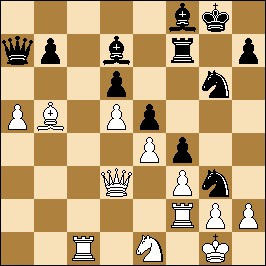Here is the tactical phase in
Anand-Morozevich, Mainz 2008 where the world champion Anand outpowered his opponent:
Position 1: White just played 21 Ng4

Here, Black could have played 21..h6 22Bd2 Rad8 with chances for both sides.
Instead, Morozevich went for the more forcing 21..Nf4.
21..Nf4? 22 Bf4 ef4Position 2 after 22..ef4. White to play
 Here, it is possible that Morozevich was initially expecting 23 Nf5 or 23 Nh5.Instead, Anand found a neat combination starting with 23 Nh6+!.
Here, it is possible that Morozevich was initially expecting 23 Nf5 or 23 Nh5.Instead, Anand found a neat combination starting with 23 Nh6+!.
23Nh6+!
Position after 23Nh6+ :Black to play
 Black cannot take the knight: 23..gh6 24 Qg4+ Kh8 25 Qf5. In this variation, 24..Bg7 is met by 25Nf5. Morozevich played the only move 23..Kh8.
Black cannot take the knight: 23..gh6 24 Qg4+ Kh8 25 Qf5. In this variation, 24..Bg7 is met by 25Nf5. Morozevich played the only move 23..Kh8.
23..Kh8
24 Nf7+ Kg8
Position 3: White to play

Here White missed an immediate finish. 25Bh7+! Kf7 26 Ng5+ Kg8 27Qb3+ Kh8 28 Qf7! and mate follows. Instead Anand played 25 Ne4.
25 Ne4
Position 4 after 25Ne4. Can Black take the knight on f7?

Here, 25..Kf7 26 Bb3+! Ke7 27 Nd6+ wins for White. on 26..Re6, 27 Ng5+ wins. The game continued as follows:
25..Ne5
26 Nfd6! Rd8 ?! ( trying to pin the knight)
27 Qh5!
The last tactical move by Anand.
Position 5 after 27Qh5!

Does Black win a piece by 27..Bd6 in Position 5 ?
The answer is no. 27..Bd6 28 Nd6 Qd6 29 Bh7+ Kf8 30 Re5 and White regains the knight on e5 with a winning attack.
Morozevich played 27..Be4 28 Ne4 h6 and after 29 Qf5, White converted his advantage and won the game in 47 moves. This game played in rapid time controls shows Anand's strength in calculating complex variations.






























